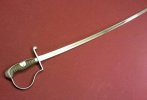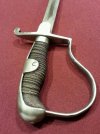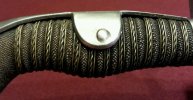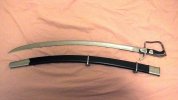Bookie, STWM, Davidf99, Kronckew and Bawanna
thank you so much everybody.
Acraglass is ordered though I only found the gel. Maybe the liquid version is out of production.
If I can push it through a large "flavor injector" syringe, I have, it should be fine. Even if its a gel, with the syringe I should be able to place it all the way in there. Once the Gel is in there I'll insert a few spacer upper takers.
I don't know if the tang is rusty but also don't see any way of fighting it without disassembling which would probably destroy the whole saber. I hope the epoxy will stabilize the tang corrosion at whatever level it is.
The
handle is wood inside :-O which means Bakelite is ruled out and its probably covered by celluloid. Both materials sure have a very similar shine to them.
There is really just that
peening at the bottom and no cross pin anywhere else on the handle though I've seen it on some other swords, probably later versions. And David's saber has it too. Its kind of duh. How could the earlier versions rely on one peen at the end and leave so much space in the handle that the tang can rotate in there? What were they thinking?
Nicks There are many. Most are around the strong part of the edge, only a few closer to the guard and some on the spine. There are also a few scratches on the flats. All the nicks have a similar width depending on how deep they penetrated. Some nicks are a bit diagonal. From this it doesn't look like some kid took an old blade and swung for the fences. It looks more like saber on saber action and resembles how my training swords are starting to look like albeit my nicks are much much smaller due to differences in steel and more likely the much thicker "edges" mine have. Since the saber isn't sharpened its for sure no war action and saber on saber doesn't necessarily mean it was training back then. It could very well be some training last week though the patine inside the nicks would speak against that.
Other interesting things are the
makers mark. It indicates that the sword was made by A C S (Alexander Coppel, Solingen). While they made cutlery they also made weapons during the Kaiser time. Later when the Nutzis gained power they didn't thank them for their service and instead took over their factory. Members of his family were put in camps and died.
Kronckew. I heard about that
cavalry against tanks myth. Luckily we have internet nowadays and can confirm or disprove such rumors more easily. Even if it were true I don't think most people would make fun of it. If anything it hints of the backwardness of the Polish army's equipment but at the same time would be a testimony to Polish courage. Also if the Nutzis would have used that as propaganda wouldn't a weak enemy have taken away from their "achievements". But maybe that was too much logic for them. What Saws did they use. Another word for machine gun? I think Poland wasn't prepared well for a fight and the attack must have come as a relative surprise. Even if Poland would have had superior airplanes they might have been destroyed on the ground if not on alert and ready to fight back. The same happened to France which on paper at least had a better or bigger army. The same problem occurs in self defense. The bad guy knows when he attacks, we don't. After we eat the first punches, kicks or stabs we see whats going on but then its probably too late to respond, already injured.
The
P guard seems like a good compromise. It's close to the upper fingers which don't move much and leaves more room for the lower fingers which move more during snap cuts for example. Of course if given the choice I'd prefer an entire "basket" around my hand.
Your are right, your (excellent looking btw)
saber blade shape looks exactly like what they used in Prussia before and during Napoleon and maybe even later. Though their handles always look very thin. So thins that the first few I saw I thought they must be fakes.

I knew about the
Tulwar blades from Europe (some from Germany as well) and was wondering what blades Indians might have used before that time. Did they forget about damascus steel and woots in between? I'm sure they must have had something useful at least. Were European steel and blade shapes better or did they just get swamped by it? That the British didn't sharpen their blades and were surprised by the Indian blades sounds unbelievable. Even from a metal sheath one can pull the blade in a way that the leading edge stays sharp. Of course only if one deems that important. But seriously even their chefs could have told them sharp = cuts better. Reading some accounts on armies from that time I'm sure most common soldiers would have had some kitchen experience. Anyways you could still be right about this, even today some of us believe a sword shouldn't be sharp...
How aggressive is
Tannic acid? Could I pour it into the handle, let it soak for some time and pour it out before injecting the epoxy or will it eat away at the wood or celluloid or even do funky things with the brass?
Thanks again everybody,
Learning a lot from you.
Edit:
Kronckew now I know how our Polish friends became part of the topic. The Ulans. The first Ulans were Polish! I was just referring to the Prussian Ulans which were a copy of the Polish original. They kept their lances until 1926. My great grandpa was one of those until 1901 when one horse kicked him and injured his lung.













